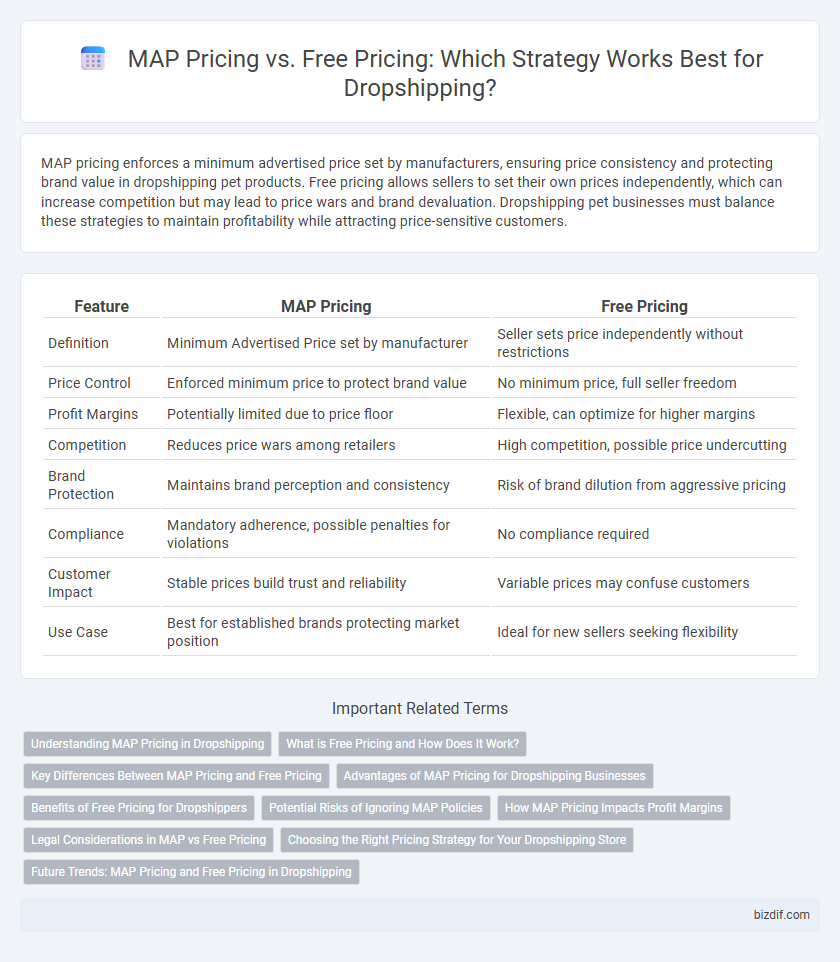MAP pricing enforces a minimum advertised price set by manufacturers, ensuring price consistency and protecting brand value in dropshipping pet products. Free pricing allows sellers to set their own prices independently, which can increase competition but may lead to price wars and brand devaluation. Dropshipping pet businesses must balance these strategies to maintain profitability while attracting price-sensitive customers.
Table of Comparison
| Feature | MAP Pricing | Free Pricing |
|---|---|---|
| Definition | Minimum Advertised Price set by manufacturer | Seller sets price independently without restrictions |
| Price Control | Enforced minimum price to protect brand value | No minimum price, full seller freedom |
| Profit Margins | Potentially limited due to price floor | Flexible, can optimize for higher margins |
| Competition | Reduces price wars among retailers | High competition, possible price undercutting |
| Brand Protection | Maintains brand perception and consistency | Risk of brand dilution from aggressive pricing |
| Compliance | Mandatory adherence, possible penalties for violations | No compliance required |
| Customer Impact | Stable prices build trust and reliability | Variable prices may confuse customers |
| Use Case | Best for established brands protecting market position | Ideal for new sellers seeking flexibility |
Understanding MAP Pricing in Dropshipping
MAP pricing in dropshipping ensures sellers adhere to a manufacturer's minimum advertised price policy, maintaining consistent price points across multiple retail platforms to prevent price wars and protect brand value. This strategy helps brands control market pricing, supports authorized retailers, and sustains perceived product quality in competitive dropshipping environments. Ignoring MAP pricing risks penalties, loss of supplier trust, and potential exclusion from dropshipping programs.
What is Free Pricing and How Does It Work?
Free pricing in dropshipping allows sellers to set their own retail prices without restrictions from manufacturers or brands, enabling competitive flexibility and personalized profit margins. This pricing model works by letting retailers adjust prices based on market demand, competitor pricing, and individual business goals, rather than adhering to manufacturer-imposed minimum advertised price (MAP) policies. Without MAP constraints, dropshippers can optimize pricing strategies to attract customers, clear inventory faster, or increase overall sales volume.
Key Differences Between MAP Pricing and Free Pricing
MAP pricing enforces a minimum advertised price set by manufacturers to maintain brand value and prevent price wars among dropshipping retailers. Free pricing allows sellers to set any price, increasing competition but potentially eroding profit margins and brand perception. The key difference lies in controlled pricing for consistency versus flexible pricing for market-driven adjustments.
Advantages of MAP Pricing for Dropshipping Businesses
MAP pricing ensures consistent product value across all sales channels, protecting brand reputation and preventing price wars among dropshipping sellers. This pricing strategy maintains healthy profit margins by preventing excessive discounting, which helps sustain supplier relationships. By enforcing MAP pricing, dropshipping businesses create a level playing field that encourages retailer collaboration and long-term market stability.
Benefits of Free Pricing for Dropshippers
Free pricing in dropshipping allows sellers to set product prices independently without adhering to manufacturers' Minimum Advertised Price (MAP) policies, enabling greater flexibility in competitive markets. This pricing freedom helps dropshippers optimize profit margins, attract price-sensitive customers, and quickly respond to demand fluctuations or promotional opportunities. Without MAP restrictions, dropshippers can implement dynamic pricing strategies that enhance market responsiveness and overall sales performance.
Potential Risks of Ignoring MAP Policies
Ignoring Minimum Advertised Price (MAP) policies can lead to significant risks such as brand devaluation and loss of supplier trust in dropshipping businesses. Violating MAP guidelines often results in account suspension, product delisting, and reduced access to premium inventory from manufacturers. Maintaining MAP compliance protects a reseller's reputation, ensures price consistency, and secures long-term partnerships with reputable suppliers.
How MAP Pricing Impacts Profit Margins
MAP pricing establishes a minimum price retailers must charge, preventing price undercutting and helping maintain stable profit margins throughout the supply chain. Adhering to MAP pricing safeguards brand value and ensures consistent revenue by avoiding price wars that erode profits. Free pricing, while potentially increasing competitive flexibility, often leads to margin compression as retailers aggressively lower prices to attract customers.
Legal Considerations in MAP vs Free Pricing
MAP pricing enforces a minimum advertised price set by manufacturers to protect brand integrity and prevent price wars, reducing legal risks associated with price discrimination under the Robinson-Patman Act. Free pricing allows retailers to set prices independently, which promotes competition but may lead to margin erosion and requires careful compliance with antitrust laws to avoid accusations of price-fixing or collusion. Dropshippers must navigate these legal considerations carefully, ensuring adherence to MAP policies when applicable and documenting pricing strategies to mitigate potential legal disputes.
Choosing the Right Pricing Strategy for Your Dropshipping Store
Selecting the right pricing strategy for your dropshipping store directly impacts profit margins and brand reputation. MAP (Minimum Advertised Price) pricing enforces a baseline price to maintain product value and prevent price wars, benefiting relationships with suppliers and ensuring sustainable competition. Free pricing grants flexibility to adjust prices based on market demand and competition but risks eroding perceived product value if not managed carefully.
Future Trends: MAP Pricing and Free Pricing in Dropshipping
Future trends in dropshipping indicate a growing adoption of Minimum Advertised Price (MAP) policies to balance brand value and competitive pricing, ensuring consistent profit margins for suppliers and retailers. Emerging e-commerce platforms increasingly integrate automated MAP enforcement tools, enabling real-time price monitoring and compliance across diverse marketplaces. Simultaneously, some dropshippers explore free pricing models to attract price-sensitive customers, leveraging dynamic pricing algorithms and AI-driven analytics to optimize sales while navigating risks of price wars and brand dilution.
MAP Pricing vs Free Pricing Infographic

 bizdif.com
bizdif.com